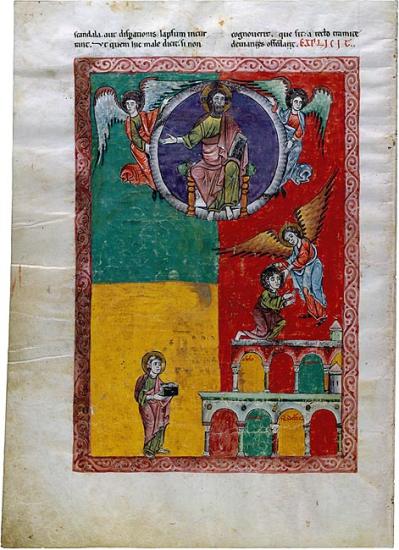
John, at the Feet of the Angel, Receives His Last Order
Beatus of Liébana
Las Huelgas Apocalypse
Purchased by Pierpont Morgan, 1910
He said to me: "These words are entirely faithful and true." And the Lord, the God of the spirits of the prophets, sent his angel to reveal to his servant what must occur soon: "For behold, I am approaching quickly! Blessed is he who keeps the words of the prophecy of this book." And I, John, after I had heard and seen, fell down in adoration before the feet of the angel. And he said to me: "Do not seal the words of the prophecy of this book. For the time is near. I am the Alpha and the Omega, the First and the Last, the Beginning and the End." Blessed are those who wash their robes in the blood of the Lamb, for they have a right to the tree of life and may enter through the gates into the city. I, Jesus, have sent my angel to testify to these things for you among the Churches. (Rev. 22:6–16)
The Apocalypse ends with this final illustration, a reconfirmation of the original command to John to record his visions and transmit the explanations to the seven churches of Asia Minor.
The Apocalypse, or Book of Revelation, is not only the last Book of the New Testament, but its most difficult, puzzling, and terrifying. It provided challenges to medieval illustrators and was the source for a number of popular images, such as Christ in Majesty, the Adoration of the Lamb, and the Madonna of the Apocalypse and contributed to the widespread use of the Evangelists' symbols.
Selected images from Apocalypse Then: Medieval Illuminations from the Morgan, an exhibition held at the Morgan are presented here. The exhibition celebrates the completion of a facsimile of the Morgan's Las Huelgas Apocalypse—the latest dated (1220) and largest surviving manuscript of a Spanish tradition of illuminated commentaries on the Apocalypse by the monk Beatus of Liébana. The series of manuscripts constitutes Spain's most important contribution to medieval manuscript illumination.
The Las Huelgas Apocalypse contains three sections: the prefatory cycle, the Apocalypse, and the Book of Daniel.
In addition to forty-nine images from the Las Huelgas Apocalypse, six images from other manuscripts in the Morgan's collections, including the earliest Beatus painted by Maius and one by the Master of the Berry Apocalypse, are in this presentation.
